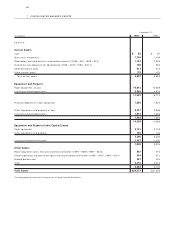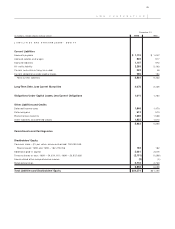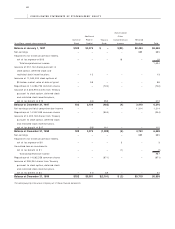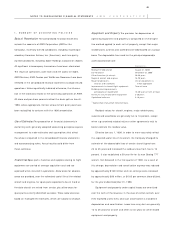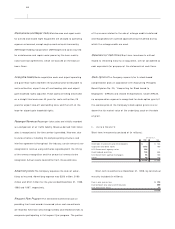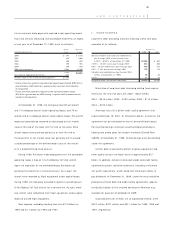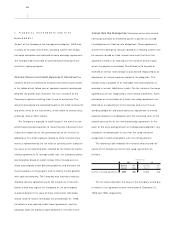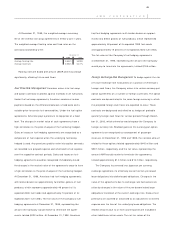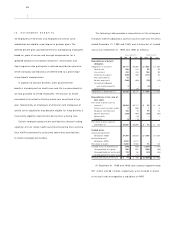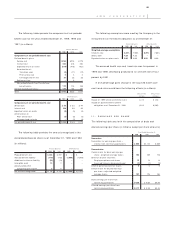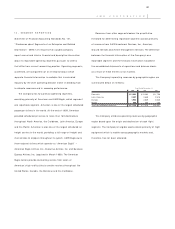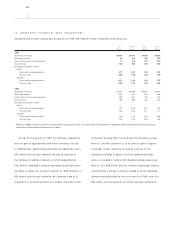American Airlines 1999 Annual Report Download - page 50
Download and view the complete annual report
Please find page 50 of the 1999 American Airlines annual report below. You can navigate through the pages in the report by either clicking on the pages listed below, or by using the keyword search tool below to find specific information within the annual report.
AMR CORPORATION
49
At December 31, 1999, the weighted-average remaining
life of the interest rate swap agreements in effect was 5.1 years.
The weighted-average floating rates and fixed rates on the
contracts outstanding were:
December 31,
1999 1998
Average floating rate 5.855% 5.599%
Average fixed rate 6.593% 6.277%
Floating rates are based primarily on LIBOR and may change
significantly, affecting future cash flows.
Fuel Price Risk Management American enters into fuel swap
and option contracts to protect against increases in jet fuel prices.
Under the fuel swap agreements, American receives or makes
payments based on the difference between a fixed price and a
variable price for certain fuel commodities. Under the fuel option
agreements, American pays a premium to cap prices at a fixed
level. The changes in market value of such agreements have a
high correlation to the price changes of the fuel being hedged.
Gains or losses on fuel hedging agreements are recognized as a
component of fuel expense when the underlying fuel being
hedged is used. Any premiums paid to enter into option contracts
are recorded as a prepaid expense and amortized to fuel expense
over the respective contract periods. Gains and losses on fuel
hedging agreements would be recognized immediately should
the changes in the market value of the agreements cease to have
a high correlation to the price changes of the fuel being hedged.
At December 31, 1999, American had fuel hedging agreements
with broker-dealers on approximately two billion gallons of fuel
products, which represents approximately 48 percent of its
expected 2000 fuel needs and approximately 10 percent of its
expected 2001 fuel needs. The fair value of the Company’s fuel
hedging agreements at December 31, 1999, representing the
amount the Company would receive to terminate the agree-
ments, totaled $232 million. At December 31, 1998, American
had fuel hedging agreements with broker-dealers on approxi-
mately two billion gallons of fuel products, which represented
approximately 48 percent of its expected 1999 fuel needs
and approximately 19 percent of its expected 2000 fuel needs.
The fair value of the Company’s fuel hedging agreements
at December 31, 1998, representing the amount the Company
would pay to terminate the agreements, totaled $108 million.
Foreign Exchange Risk Management To hedge against the risk
of future exchange rate fluctuations on a portion of American’s
foreign cash flows, the Company enters into various currency put
option agreements on a number of foreign currencies. The option
contracts are denominated in the same foreign currency in which
the projected foreign cash flows are expected to occur. These
contracts are designated and effective as hedges of probable
quarterly foreign cash flows for various periods through Decem-
ber 31, 2000, which otherwise would expose the Company to
foreign currency risk. Realized gains on the currency put option
agreements are recognized as a component of passenger
revenues. At December 31, 1999 and 1998, the notional amount
related to these options totaled approximately $445 million and
$597 million, respectively, and the fair value, representing the
amount AMR would receive to terminate the agreements,
totaled approximately $14 million and $10 million, respectively.
The Company has entered into Japanese yen currency
exchange agreements to effectively convert certain yen-based
lease obligations into dollar-based obligations. Changes in the
value of the agreements due to exchange rate fluctuations are
offset by changes in the value of the yen-denominated lease
obligations translated at the current exchange rate. Discounts or
premiums are accreted or amortized as an adjustment to interest
expense over the lives of the underlying lease obligations. The
related amounts due to or from counterparties are included in
other liabilities or other assets. The net fair values of the



